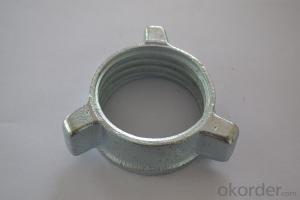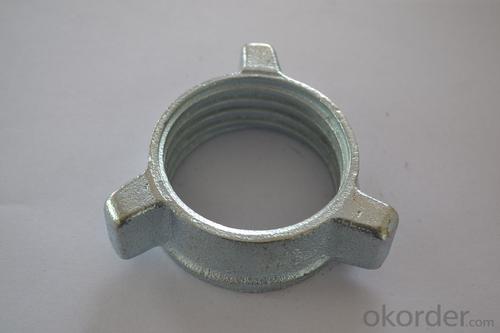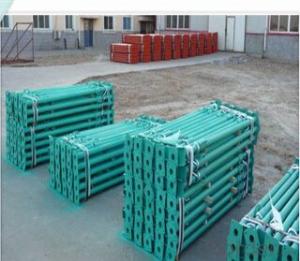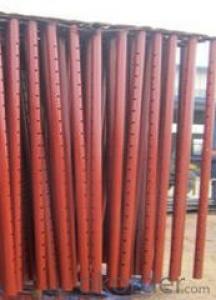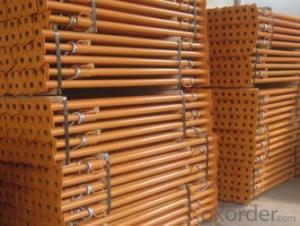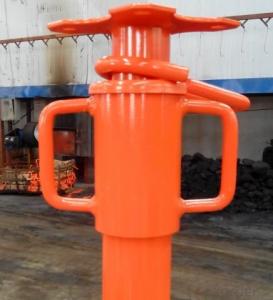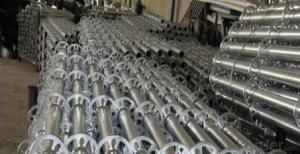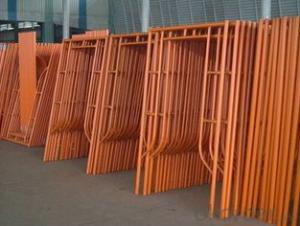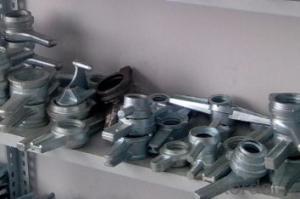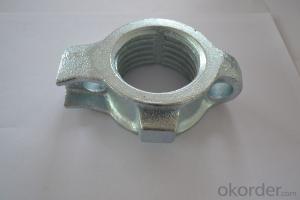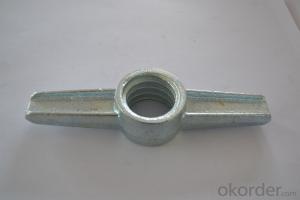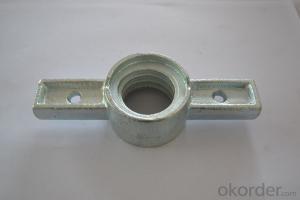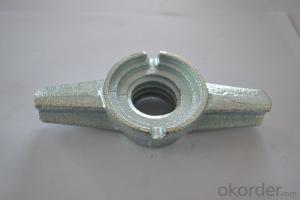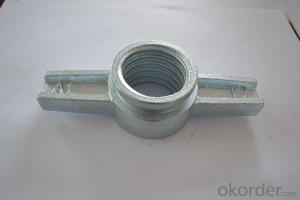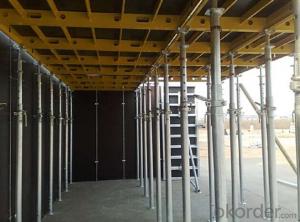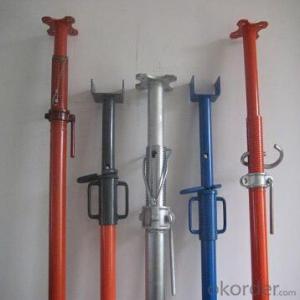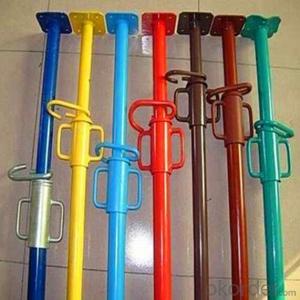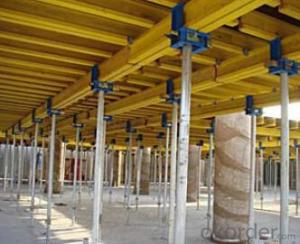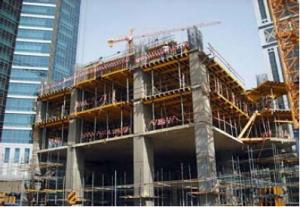OEM Two wing Butterfly Wing Nuts 11
- Loading Port:
- China Main Port
- Payment Terms:
- TT OR LC
- Min Order Qty:
- -
- Supply Capability:
- -
OKorder Service Pledge
OKorder Financial Service
You Might Also Like
Quick Details
| Model Number: | |||||
| Standard: | Type: | Certification: | |||
| Material: | Surface: |
Packaging & Delivery
| Packaging Detail: | Plastic bag, pallet packing, carton box, by customer's requirement |
| Delivery Detail: | within 30days after payment |
Specifications
Two wing Butterfly Wing Nuts
1>Excellent dimension accuracy
2>Finished: per your requirements
3>factory directly supply
Two wing Butterfly Wing Nuts
We supply kinds of metal parts totally according to clients' drawings and samples and special requirement.
1. Material: Ductile iron .
2. Sizes: Inner hole Dia 15/17mm.
We have different sizes ,types of wing nut to meet your needs, save your cost .
3. Weight: 0.35kg,thread pitch: 10.0mm.(or 6.35mm)
4. Surface: White Zinic , Yellow Zinic or painted, self color
5 Thread:casted or machine tap.
1. 12000M2 standard modern workshop guarantee production capability to satisfy the customers needs
2. Our Independent quality control department,Which make sure the quality of all products
3. Our efficient and experienced sales team ,provide friendly and thoughtful service for clients from all over the world
- Q: Can steel props be used in commercial building construction?
- Yes, steel props can be used in commercial building construction. Steel props, also known as adjustable steel props or steel acrow props, are commonly used in construction projects to support and stabilize temporary structures. They are typically used to provide temporary support for beams, slabs, walls, and ceilings during construction or renovation work. Steel props are highly versatile and can be adjusted to different heights, making them suitable for use in commercial building construction where various height requirements may arise. They are made of high-quality steel, providing strength and durability, and can withstand heavy loads. In commercial building construction, steel props are often used in conjunction with other support systems such as scaffolding to provide additional stability and safety. They can be easily installed and adjusted to the desired height, providing a reliable and secure temporary support system. Moreover, steel props are designed to meet industry safety standards and regulations, ensuring that they can be safely used in commercial building construction. They undergo rigorous testing and quality control measures to ensure their reliability and performance. Overall, steel props are a popular choice in commercial building construction due to their strength, adjustability, and versatility. They provide temporary support and stability, allowing for efficient and safe construction processes.
- Q: Can steel props be used with adjustable bases?
- Yes, steel props can be used with adjustable bases. Steel props are sturdy and can provide support for various types of structures, while adjustable bases allow for flexibility in setting the desired height or level. Therefore, combining steel props with adjustable bases can provide a stable and customizable support solution.
- Q: What are the limitations of using steel props?
- There are several limitations associated with using steel props in construction and temporary support systems. 1. Weight and handling: Steel props can be heavy and difficult to transport, especially when working on higher levels of a building or in confined spaces. The weight can also make them challenging to manipulate and adjust during installation and removal. 2. Limited adjustability: While steel props offer some adjustability, their range may not be sufficient for all applications. Adjusting the height of steel props can be time-consuming and may require additional tools or equipment. 3. Load capacity: Steel props have a limited load-bearing capacity. Depending on the specific type and size of the prop, they may not be able to support heavy loads or withstand excessive forces. This limitation can restrict their use in certain construction projects, especially those requiring extensive structural support. 4. Corrosion: Steel props are prone to corrosion when exposed to moisture, chemicals, or harsh environmental conditions. If not properly maintained or protected, this corrosion can weaken the props over time, reducing their overall strength and stability. 5. Limited structural versatility: Steel props are primarily designed for vertical support and may not be suitable for certain structural configurations or unconventional building layouts. They may not provide adequate stability or alignment in non-standard situations, requiring alternative support systems to be used. 6. Cost: Steel props can be expensive to purchase or rent, especially for long-term projects or when a large number of props are required. The cost of transportation, storage, and maintenance should also be considered when using steel props. 7. Safety concerns: Steel props require proper installation and regular inspections to ensure they are secure and stable. Failure to do so can result in accidents, injuries, or structural damages. Additionally, steel props can pose a tripping hazard if not properly positioned or secured. It is important to carefully assess the specific requirements of a project and consider alternative support systems when necessary to overcome the limitations of using steel props.
- Q: Can steel props be used for supporting temporary fencing?
- Certainly, temporary fencing can be supported using steel props. Thanks to their sturdiness and durability, steel props prove to be an ideal choice for providing support to temporary fencing structures. One advantage they offer is the ease with which they can be adjusted to the desired height, while also being capable of withstanding the weight and pressure exerted on the fencing. Moreover, steel props exhibit versatility, enabling their use in diverse construction and temporary fencing applications.
- Q: Can steel props be used in the construction of temporary access ramps?
- Yes, steel props can be used in the construction of temporary access ramps. Steel props are commonly used in construction to provide temporary support and stability to structures. They are adjustable and can be set to the desired height, making them ideal for creating ramps with the necessary incline for accessibility. Steel props are strong and durable, capable of withstanding heavy loads, which is essential for ensuring the safety of individuals using the ramp. Additionally, their versatility allows for easy installation and dismantling, making them suitable for temporary construction projects such as access ramps. Overall, steel props are a reliable choice for constructing temporary access ramps due to their strength, adjustability, and ease of use.
- Q: What are the guidelines for the proper installation and removal of steel props?
- The guidelines for the proper installation and removal of steel props include ensuring the props are of appropriate size and strength for the intended load, properly positioning and aligning the props, securing them tightly in place, and regularly inspecting them for any signs of damage or fatigue. During removal, the props should be carefully disassembled, avoiding any sudden or forceful actions that could cause injury or damage. It is crucial to follow manufacturer instructions and adhere to relevant safety regulations to ensure the safe and effective use of steel props.
- Q: How do steel props prevent sagging and settling of floors?
- To support floors and prevent sagging and settling, construction utilizes steel props. These props are composed of adjustable metal tubes that can be extended or shortened to the desired height. When properly installed, steel props create a robust and secure support system for floors. They effectively transfer the structure's weight to the ground, evenly distributing it and preventing excessive pressure on any specific area. This mechanism effectively prevents sagging and settling over time. The adjustability of steel props plays a vital role in preventing sagging and settling. As construction progresses, the props can be easily adjusted to accommodate changes in load distribution, ensuring that the floors remain level and stable. This flexibility allows for effortless correction of any potential issues that may arise during the construction process. Moreover, steel props are manufactured from durable and sturdy materials, providing exceptional strength and load-bearing capacity. This guarantees their ability to support the weight of the floors and withstand the forces exerted on them, eliminating any possibility of bending or buckling. This stability is crucial in preventing sagging and settling, as any structural deformations can result in uneven floors and potential safety hazards. In conclusion, steel props effectively prevent sagging and settling by establishing a sturdy and stable support system. Their adjustability enables easy corrections and ensures the maintenance of level floors throughout the construction process. The durability of steel props guarantees their ability to withstand weight and forces, safeguarding against any structural deformations that could lead to sagging or settling.
- Q: What are the different weight classes available for steel props?
- The different weight classes available for steel props typically range from light-duty to heavy-duty, with weight capacities varying from 20kN to 80kN or more. These weight classes are designed to accommodate different construction needs and load requirements, ensuring the proper support and stability for various building projects.
- Q: Can steel props be used to support temporary stages or platforms?
- Yes, steel props can be used to support temporary stages or platforms. Steel props, also known as adjustable steel props or steel shores, are sturdy and reliable support systems commonly used in construction and temporary structures. They are designed to provide vertical support and can be adjusted to different heights, making them suitable for various applications, including supporting temporary stages or platforms. Steel props are easy to install, durable, and can bear heavy loads, making them a preferred choice for ensuring the stability and safety of temporary structures.
- Q: Are steel props adjustable with a single person?
- No, steel props are typically not adjustable with a single person. Steel props, also known as steel acrow props or steel adjustable props, are used in construction to support or shore up temporary structures such as scaffolding or formwork. These props consist of a steel tube with an adjustable screw mechanism at one end and a flat plate or U-shaped head at the other end. To adjust the height of a steel prop, it is necessary to rotate the screw mechanism, which can be quite heavy and requires significant force to operate. Therefore, it is generally advised to have at least two people involved in the adjustment process. One person holds the prop steady while the other person rotates the screw to raise or lower the prop to the desired height. The involvement of two people ensures that the adjustment process is carried out safely and efficiently. It allows for better control over the prop's movement and minimizes the risk of accidents or injuries that could occur if a single person attempts to adjust it alone. Additionally, having another person present can provide assistance in case of any unexpected issues or difficulties during the adjustment process. In summary, due to the weight and force required to adjust steel props, it is recommended to have at least two people involved in the process for safety and efficiency reasons.
Send your message to us
OEM Two wing Butterfly Wing Nuts 11
- Loading Port:
- China Main Port
- Payment Terms:
- TT OR LC
- Min Order Qty:
- -
- Supply Capability:
- -
OKorder Service Pledge
OKorder Financial Service
Similar products
Hot products
Hot Searches
Related keywords
